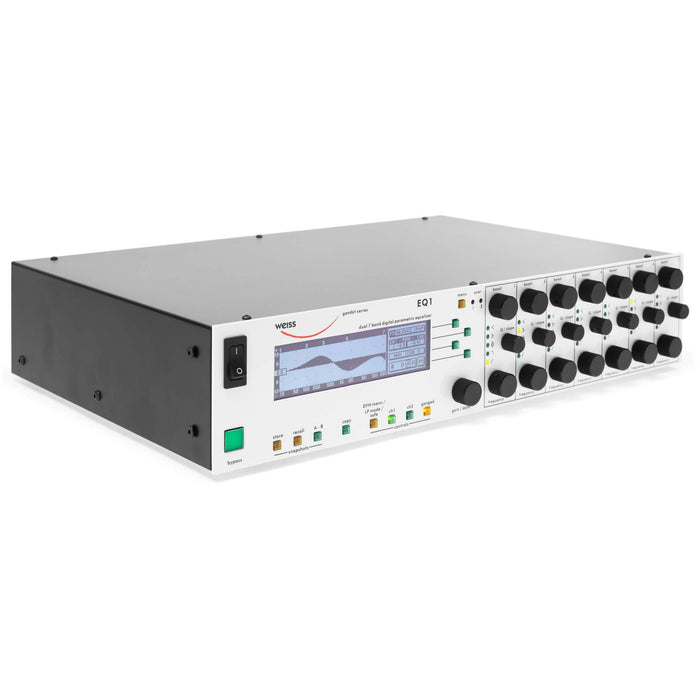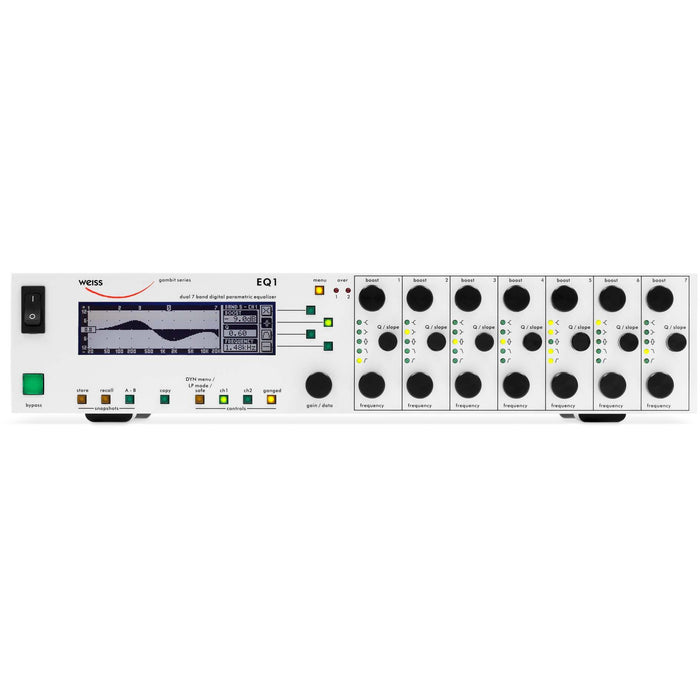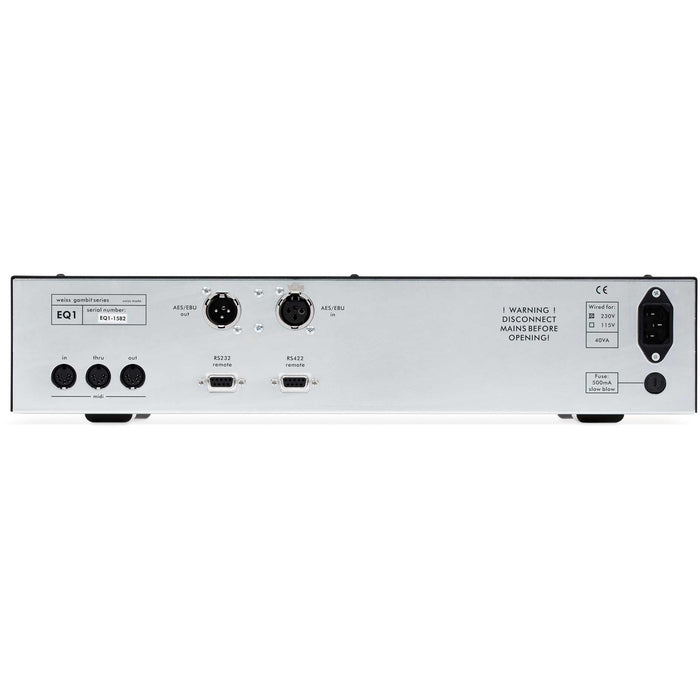Weiss EQ1-DYN - Dynamic Phase, 96 kHz, 2-channel, 7-band parametric equalizer
£7,178.68 ex. vat
Weiss EQ1-DYN
The Weiss EQ1-DYN is a two channel digital equalizer with parametric and dynamic bands. It has digital inputs/outputs exclusively which work at up to 24 Bit/96 kHz.
EQ1-DYN, the EQ1-MK2 with four dynamic bands
The EQ1-DYN features four freely adjustable dynamic bands, and additionally three linear bands per channel. Setting up the dynamic bands is as easy as setting a linear band. There is just one additional parameter to be adjusted by the user, the threshold control. This makes multi-band dynamic control as easy and as versatile as adjusting a parametric equalizer. The dynamic EQ can be used as a de-esser or to give the bass an extra punch etc..
Bands 1, 2, 5 and 6 are the dynamic bands (each individually switchable to linear) and bands 3, 4 and 7 are ordinary linear bands. A dynamic band operates similar to a compressor, with two additional features:
1) The band is sensitive to signal level in its frequency range only. So when applying dynamic bass EQ, only the bass-band of the program affects the dynamic behavior. There is no cross-modulation from other bands.
2) The gain is only applied to certain frequencies, and not across the whole audio band.
3) Other modes (low-cut, high-cut, low-shelving, high-shelving) are linear (no automatic boost/cut adjustment), and behave exactly the same as in the EQ1-MK2.
The reason for choosing exactly bands 1, 2, 5 and 6 is the following: As the name implies, a dynamic band is sensitive to the level of the input signal. Sometimes it is desirable to first add some EQ, and afterwards dynamically add some more. Or vice versa, first do some dynamic corrections and afterwards add overall EQ, including in the corrected band. Because the EQ bands are connected in series, this is only possible if there are linear bands before and after the dynamic bands.
Weiss EQ1-DYN Features
Basic EQ1 functions
The basic features are common to all four models, namely the seven identical parametric bands, i.e. all seven bands cover the entire audio frequency range. Each band has Boost/Cut, Frequency and Q/Slope knobs and operates in any of the following modes: High shelving, low shelving, peaking, high cut, low cut, bypass.
Controls, display
There are seven times three knobs in order to have “one knob per parameter” operation. The knobs are touch sensitive to switch the LCD to display the parameters of the touched band. The LCD shows the overall frequency response, the detailed parameter values and various status information.
Snapshots, MIDI, metering
Other basic features are an A/B compare memory, a 128 position snapshot bank with two additional banks for back-up (can also be dumped/recovered via MIDI), a peak meter with over indicators, MIDI control for each parameter, an overall bypass switch and an overall gain control, a channel ganging switch.
Signal processing, connectivity
The internal processing is done at 88.2 or 96 kHz in a 40 Bit floating-point format. A very low noise filter architecture optimized for audio is used. The digital input/output are in AES/EBU format on XLR connectors. The AES/EBU output can be POW-R dithered to 16, 20 or 24 Bits.
M/S mode
The EQ1 can be switched to M/S mode which is especially useful for the
dynamic model of the EQ1. Also see the article: “Stereo Shuffling: New Approach – Old Technique” by Michael Gerzon. Other specialties are variable slope shelving filters and very high Q (up to 650) peaking filters for notching out offending frequencies.
Specifications
Power
- Mains voltage: 115 V or 230 V with voltage selector
- Fuse rating: 500 mA slow blow
- Power consumption: 40 VA max.
Size
- Depth: 30 cm
- Width: 43,3 cm (19")
- Height: 8,8 cm (2HU)
AES/EBU Input
- Sampling frequencies: 44.1 kHz, 48 kHz, 88.2 kHz, 96 kHz
- Maximum input word-length: 24 Bits
- Channel Status Data: Input accepts professional or consumer format
- Channel Status Data Bits forwarded to AES/EBU output: see table below
- Connector: XLR female
AES/EBU Output
- Sampling frequencies: 44.1 kHz, 48 kHz, 88.2 kHz, 96 kHz (always the same as the input)
- Output word-length: 24 Bits
- Connector: XLR male
AES/EBU Channel Status Data
- The EQ1 allows to convert the incoming Channel Status Data as follows:
- From Consumer to Professional
- From Professional to Consumer
- Transparent mode, i.e. Channel Status Data is fed forward to the output without any conversion (one exception, see below)
Dither:
- Dithering algorithms are implemented using the POW-R set of algorithms, i.e. POW-R #1, POW-R #2, POW-R #3
MIDI Remote Control Protocol
- All band parameters plus the controls parameters are remote controllable. Each parameter has its corresponding MIDI controller number. According to the different parameters, the controllers are limited in their range. Invalid values are replaced by the maximum allowable values. Details can be found in the EQ1 manuals.



